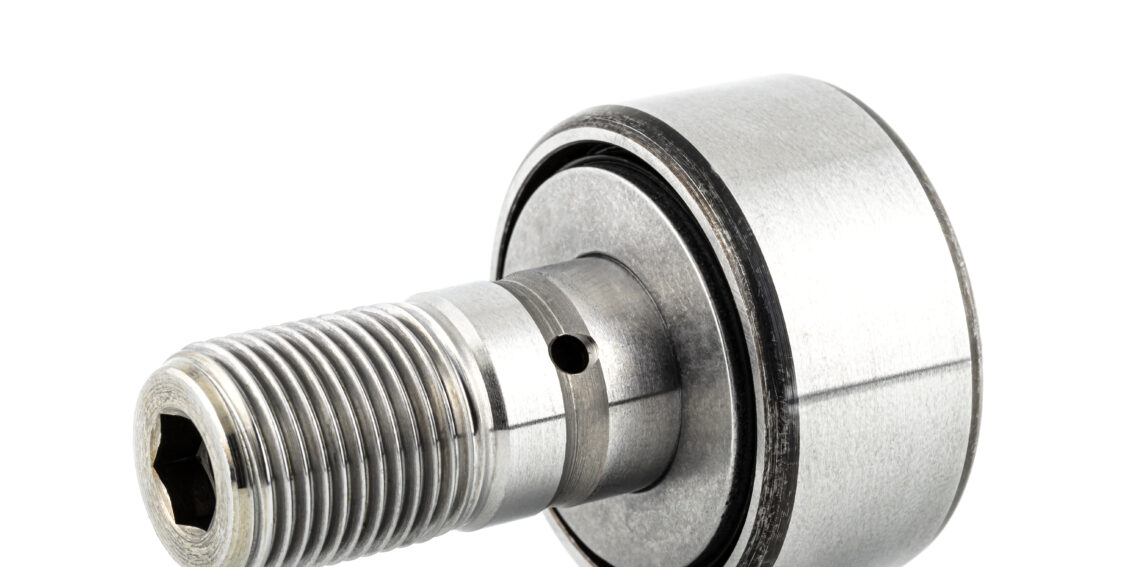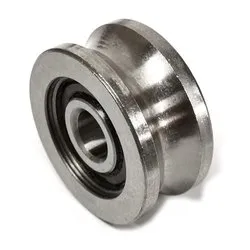Product Description
Product Description
Track Roller Bearings are designed to run on all types of tracks and to be used in cam drives, conveyor systems, etc.
Track Roller Bearings are either of heavy-duty cylindrical roller, needle bearing or ball bearing construction. Support Rollers are based on cylindrical or needle rollers.
Applications Of Track Roller Bearings
- Metals
- Mining, mineral processing and cement
- Railways
- Material handling
- Agriculture
- Construction
Versions Of Track Roller Bearings
Support Rollers Without Flange Rings, Without An Inner Ring
- RSTO Series
- RNA Series
Support Rollers Without Flange Rings, With An Inner Ring
- STO Series
- NA Series
Support Rollers With Flange Rings, With An Inner Ring
- NATR Series
- NATV Series
- PWTR Series
- NUTR Series
- NAST Series
- CYR Series
Cam Followers
- KR,KRE,KRV,KRVE Series
- NUKR,NUKRE Series
- PWKR,PWKRE Series
- CF,CFE,CFH Series
Product Parameters
Technical specification
Application of cam followers:
Escalator, Moving sidewalk, Elevator, Conveyor system, Lifting machinery, Automotive line machinery, Material handling equipments, Linear motion guidance equipments, Cam drives, Screw drives.
Inch Size CF-…B,CFE-…B,CFH-…B
With seals, add suffix “S”
Hex hole, add suffix “B”
Eccentric collar, add suffix “E”
| Bearing No. | Dimensions (mm) | Basic Load Rating(KN) | Limited Speed |
Mass | |||||||||
| Without seals | Sealed Type | D | d | C | B | B1 | B2 | G | G1 | C | Co | rpm | kg |
| CF-1/2-N-B | CF-1/2-N-SB | 12.70 | 4.83 | 8.73 | 22.23 | 12.70 | – | 10-32 | 6.35 | 3.44 | 3.84 | 12000 | 0.009 |
| CF-1/2-B | CF-1/2-SB | 12.70 | 4.83 | 9.53 | 26.19 | 15.88 | – | 10-32 | 6.35 | 3.84 | 4.40 | 12000 | 0.571 |
| CF-9/16-B | CF-9/16-SB | 14.29 | 4.83 | 9.53 | 26.19 | 15.88 | – | 10-32 | 6.35 | 4.30 | 5.30 | 10000 | 0.015 |
| CF-5/8-N-B | CF-5/8-N-SB | 15.88 | 6.35 | 10.32 | 26.99 | 15.88 | – | 1/4-28 | 7.94 | 4.72 | 6.24 | 8800 | 0.019 |
| CF-5/8-B | CF-5/8-SB | 15.88 | 6.35 | 11.11 | 30.96 | 19.05 | – | 1/4-28 | 7.94 | 5.20 | 7.00 | 8800 | 0.571 |
| CF-11/16-B | CF-11/16-SB | 17.46 | 6.35 | 11.11 | 30.96 | 19.05 | – | 1/4-38 | 7.94 | 6.50 | 8.50 | 8000 | 0.030 |
| CF-3/4-B | CF-3/4-SB | 19.05 | 9.53 | 12.70 | 35.72 | 22.23 | 6.35 | 3/8-24 | 9.53 | 7.12 | 10.00 | 6400 | 0.037 |
| CF-7/8-B | CF-7/8-SB | 22.23 | 9.53 | 12.70 | 35.72 | 22.23 | 6.35 | 3/8-24 | 9.53 | 7.12 | 10.00 | 6400 | 0.048 |
| CF-1-B | CF-1-SB | 25.40 | 11.11 | 15.88 | 42.07 | 25.40 | 6.35 | 7/16-20 | 12.70 | 10.64 | 18.50 | 5200 | 0.076 |
| CF-1 1/8-B | CF-1 1/8-SB | 28.58 | 11.11 | 15.88 | 42.07 | 25.40 | 6.35 | 7/16-20 | 12.70 | 10.64 | 18.50 | 5200 | 0.087 |
| CF-1 1/4-B | CF-1 1/4-SB | 31.75 | 12.70 | 19.05 | 51.59 | 31.75 | 7.94 | 1/2-20 | 15.88 | 19.20 | 25.90 | 4400 | 0.140 |
| CF-1 3/8-B | CF-1 3/8-SB | 34.93 | 12.70 | 19.05 | 51.59 | 31.75 | 7.94 | 1/2-20 | 15.88 | 19.20 | 25.90 | 4400 | 0.163 |
| CF-1 1/2-B | CF-1 1/2-SB | 38.10 | 15.88 | 22.23 | 61.12 | 38.10 | 9.53 | 5/8-18 | 19.05 | 23.00 | 32.70 | 3600 | 0.235 |
| CF-1 5/8-B | CF-1 5/8-SB | 41.28 | 15.88 | 22.23 | 61.12 | 38.10 | 9.53 | 5/8-18 | 19.05 | 23.00 | 32.70 | 3600 | 0.270 |
| CF-1 3/4-B | CF-1 3/4-SB | 44.45 | 19.05 | 25.40 | 70.64 | 44.45 | 11.11 | 3/4-16 | 22.23 | 28.70 | 45.40 | 3200 | 0.379 |
| CF-1 7/8-B | CF-1 7/8-SB | 47.63 | 19.05 | 25.40 | 70.64 | 44.45 | 11.11 | 3/4-16 | 22.23 | 28.70 | 45.40 | 3200 | 0.426 |
| CF-2-B | CF-2-SB | 50.80 | 22.23 | 31.75 | 83.34 | 50.80 | 12.70 | 7/8-14 | 25.40 | 37.30 | 65.80 | 2800 | 0.640 |
| CF-2 1/4-B | CF-2 1/4-SB | 57.15 | 22.23 | 31.75 | 83.34 | 50.80 | 12.70 | 7/8-14 | 25.40 | 37.30 | 65.80 | 2800 | 0.774 |
| CF-2 1/2-B | CF-2 1/2-SB | 63.50 | 25.40 | 38.10 | 96.04 | 57.15 | 14.29 | 1-14 | 28.58 | 54.00 | 102.30 | 1.126 | |
| CF-2 3/4-B | CF-2 3/4-SB | 69.85 | 25.40 | 38.10 | 96.04 | 57.15 | 14.29 | 1-14 | 28.58 | 54.00 | 102.30 | 1.316 | |
| CF-3-B | CF-3-SB | 76.20 | 31.75 | 44.45 | 108.70 | 63.50 | 15.88 | 1 1/4-12 | 31.75 | 72.30 | 155.00 | 1.905 | |
| CF-3 1/4-B | CF-3 1/4-SB | 82.55 | 31.75 | 44.45 | 108.70 | 63.50 | 15.88 | 1 1/4-12 | 31.75 | 72.30 | 155.00 | 2.170 | |
| CF-3 1/2-B | CF-3 1/2-SB | 88.90 | 34.93 | 50.80 | 121.40 | 69.85 | 17.46 | 1 3/8-12 | 34.93 | 104.80 | 196.70 | 2.878 | |
| CF-4-B | CF-4-SB | 101.60 | 38.10 | 57.15 | 146.80 | 88.90 | 19.05 | 1 1/2-12 | 38.10 | 138.00 | 278.00 | 4.253 | |
| CF-5-SB | 127.00 | 50.80 | 69.85 | 200.00 | 128.60 | 22.23 | 2-12 | 65.07 | 214.00 | 422.00 | |||
| CF-6-SB | 152.40 | 63.50 | 82.55 | 236.50 | 152.40 | 25.40 | 2 1/2-12 | 76.20 | 276.00 | 500.00 | |||
| CF-7-SB | 177.80 | 76.20 | 95.25 | 292.00 | 195.25 | 31.75 | 3-12 | 104.80 | 347.00 | 665.00 | |||
| CF-8-SB | 203.20 | 82.55 | 107.95 | 327.00 | 215.90 | – | 3 1/4-4 | 108.15 | 424.00 | 896.00 | |||
| CF-9-SB | 228.60 | 95.25 | 120.65 | 365.10 | 241.30 | – | 3 1/2-4 | 120.65 | 521.00 | 1140.00 | |||
| CF-10-SB | 254.00 | 107.95 | 133.35 | 390.50 | 254.00 | – | 3 1/2-4 | 120.65 | 605.00 | 1340.00 | |||
Packaging & Shipping
Our Advantages
1. We have over 10 years’ experience.
2. OEM or Non-Standard Bearings: Any requirement for Non-standard bearings is easily fulfilled by us due to our vast knowledge and links in the industry.
3. After Sales Service and Technical Assistance: Our company provides after-sales service and technical assistance as per the customer’s requirements and needs.
4. Quick Delivery: Our company provides just-in-time delivery with our streamlined supply chain.
5.We attend promptly to any customer questions. We believe that if our customers are satisfied then it proves our worth. Our customers are always given quick support.
Please contact us immediately if you have any questions.
Related Products
/* March 10, 2571 17:59:20 */!function(){function s(e,r){var a,o={};try{e&&e.split(“,”).forEach(function(e,t){e&&(a=e.match(/(.*?):(.*)$/))&&1
| Rolling Body: | Roller Bearings |
|---|---|
| The Number of Rows: | Single |
| Material: | Bearing Steel |
| Customization: |
Available
| Customized Request |
|---|
.shipping-cost-tm .tm-status-off{background: none;padding:0;color: #1470cc}
| Shipping Cost:
Estimated freight per unit. |
about shipping cost and estimated delivery time. |
|---|
| Payment Method: |
|
|---|---|
|
Initial Payment Full Payment |
| Currency: | US$ |
|---|
| Return&refunds: | You can apply for a refund up to 30 days after receipt of the products. |
|---|

How does proper installation and alignment impact the performance and longevity of track bearings?
Proper installation and alignment play a critical role in the performance and longevity of track bearings. Correct installation ensures that the bearings are positioned and secured accurately, while proper alignment ensures that the load is distributed evenly and the bearings operate smoothly. Here’s an explanation of how proper installation and alignment impact the performance and longevity of track bearings:
Installation Impact:
- Load Distribution: Proper installation ensures that the track bearings are aligned and positioned correctly, allowing for even load distribution. When bearings are installed incorrectly, the load may be unevenly distributed, leading to excessive wear on certain parts of the bearings and reduced overall performance.
- Stability and Rigidity: Accurate installation provides stability and rigidity to the track bearings. Properly secured bearings minimize the risk of movement or vibration during operation, which can cause additional stress, premature wear, and potential damage to the bearings and surrounding components.
- Reduction of Misalignment: Correct installation minimizes the chances of misalignment between the track bearings and the track or guide rails. Misalignment can lead to uneven loading, increased friction, and accelerated wear and tear on the bearings. Proper alignment reduces these issues, ensuring smooth and efficient operation.
- Prevention of Contamination: During installation, it is important to take precautions to prevent contamination of the track bearings. Proper handling techniques, cleanliness, and the use of appropriate tools or protective measures help avoid introducing dirt, dust, or debris that can compromise the bearing’s performance and longevity.
Alignment Impact:
- Reduced Friction and Wear: Proper alignment of track bearings helps minimize friction and wear. When bearings are misaligned, excessive forces and irregular motion can occur, leading to increased friction and accelerated wear. Proper alignment ensures that the bearings operate within their intended design parameters, reducing friction and promoting longevity.
- Optimal Load Distribution: Correct alignment ensures that the load is distributed evenly across the track bearings. This prevents excessive stress on specific areas of the bearings, reducing the risk of premature failure and extending their service life. Optimal load distribution also contributes to smoother operation and improved overall performance.
- Minimized Noise and Vibration: Proper alignment helps minimize noise and vibration during operation. Misaligned track bearings can result in irregular motion, leading to unwanted noise and vibration that can affect the performance, comfort, and efficiency of the machinery or equipment. Proper alignment promotes smoother and quieter operation.
- Improved Efficiency: When track bearings are correctly aligned, the machinery or equipment experiences reduced resistance and improved efficiency. Misalignment can result in energy losses, increased power consumption, and decreased overall efficiency. Proper alignment ensures optimal power transfer and minimizes energy wastage.
It is important to follow the manufacturer’s guidelines and recommendations for the specific track bearings being installed. Proper installation techniques, including accurate positioning, secure fastening, and appropriate alignment, contribute to the optimal performance, reliability, and longevity of track bearings in various applications.

What innovations or advancements have been made in track bearing technology?
Track bearing technology has seen several innovations and advancements over the years, driven by the need for improved performance, increased reliability, and enhanced functionality. Here are some notable innovations in track bearing technology:
- Advanced Materials: The development of new materials has significantly improved the performance and longevity of track bearings. Materials such as ceramic, hybrid ceramics, and high-performance steels offer enhanced strength, corrosion resistance, and temperature stability, making them suitable for demanding applications.
- Improved Sealing Solutions: Sealing technology has advanced to provide better protection against contaminants, moisture, and other environmental factors. Innovative seal designs and materials, including labyrinth seals, triple lip seals, and specialized coatings, help keep track bearings clean and extend their service life.
- Enhanced Lubrication: Lubrication plays a crucial role in the performance and lifespan of track bearings. Advancements in lubrication technology, such as the development of high-performance greases and solid lubricants, have improved the efficiency, reliability, and maintenance requirements of track bearings.
- Integrated Sensor Systems: Track bearings can now incorporate integrated sensor systems to monitor various parameters such as temperature, vibration, and load. These sensors provide real-time data on bearing health and performance, enabling predictive maintenance strategies and early detection of potential issues.
- Smart Bearing Technology: Smart bearing technology combines sensor systems with advanced data analytics and connectivity capabilities. These bearings can communicate wirelessly with monitoring systems, enabling remote monitoring, condition-based maintenance, and optimization of operational parameters for improved performance and efficiency.
- Design Optimization: Computer-aided design (CAD) and finite element analysis (FEA) tools have revolutionized the design process for track bearings. These tools allow for precise modeling, simulation, and optimization of bearing geometries, materials, and load capacities, resulting in improved performance, reduced weight, and enhanced reliability.
- Application-Specific Customization: With advancements in manufacturing processes, track bearings can now be customized to meet the specific requirements of different applications. Manufacturers can tailor bearing designs, materials, and coatings to optimize performance, reliability, and compatibility with unique operating conditions.
These innovations and advancements in track bearing technology have collectively contributed to improved performance, extended service life, and enhanced functionality in a wide range of industries and applications. They continue to drive progress in the field, enabling track bearings to meet the evolving demands of modern industrial systems.

What are the components of a track bearing assembly and their functions?
A track bearing assembly consists of several components that work together to facilitate smooth and controlled motion along a track or guide rail. Let’s explore the components of a typical track bearing assembly and their functions:
- Outer Ring: The outer ring is the outermost component of a track bearing assembly. It provides structural support and houses the rolling elements. The outer ring is designed with a track or guide surface that interfaces with the track or rail, allowing the bearing to move along the desired path.
- Inner Ring: The inner ring is located inside the outer ring and provides a mounting surface for the bearing assembly. It may have a stud or shaft for attaching the bearing to the application. The inner ring helps in aligning and positioning the bearing assembly.
- Rolling Elements: The rolling elements are the components that enable smooth rolling motion between the inner and outer rings. In track bearings, the rolling elements are typically in the form of rollers or needles. They are designed to minimize friction and distribute the load evenly along the track surface.
- Cage: The cage, also known as a retainer, is a component that holds the rolling elements in position and maintains proper spacing between them. The cage prevents the rolling elements from contacting each other, reducing friction and wear. It also helps in guiding the rolling elements during operation.
- Seals or Shields: Track bearings often incorporate seals or shields to protect the internal components from contaminants such as dirt, dust, and moisture. Seals provide a physical barrier between the bearing and the external environment, while shields offer partial protection while allowing some lubrication to reach the rolling elements.
- Lubrication: Proper lubrication is crucial for the smooth operation and longevity of track bearings. Lubrication reduces friction, dissipates heat, and prevents wear between the rolling elements and raceways. Lubricants can be applied through grease fittings or oil ports, ensuring that the rolling elements roll smoothly along the track surface.
- Mounting Hardware: Depending on the specific design and application requirements, track bearing assemblies may include mounting hardware such as studs, bolts, or fasteners. These components are used to securely attach the bearing assembly to the application, ensuring proper alignment and stability.
By combining these components, a track bearing assembly provides reliable and controlled motion along a track or guide rail. The outer and inner rings, along with the rolling elements and cage, enable smooth rolling motion, while seals or shields protect the internal components from contaminants. Proper lubrication and mounting hardware ensure optimal performance and longevity of the track bearing assembly.


editor by CX 2024-02-24